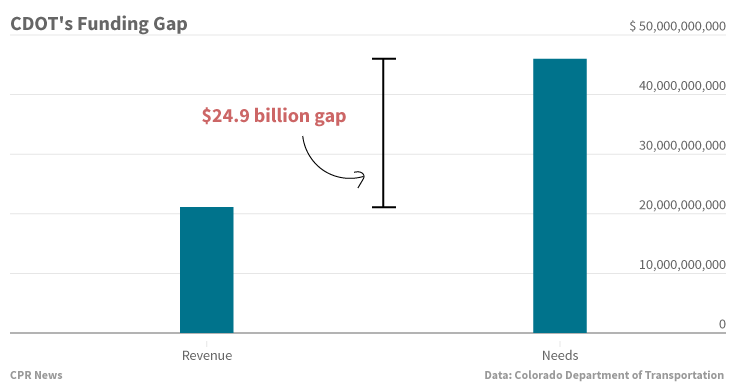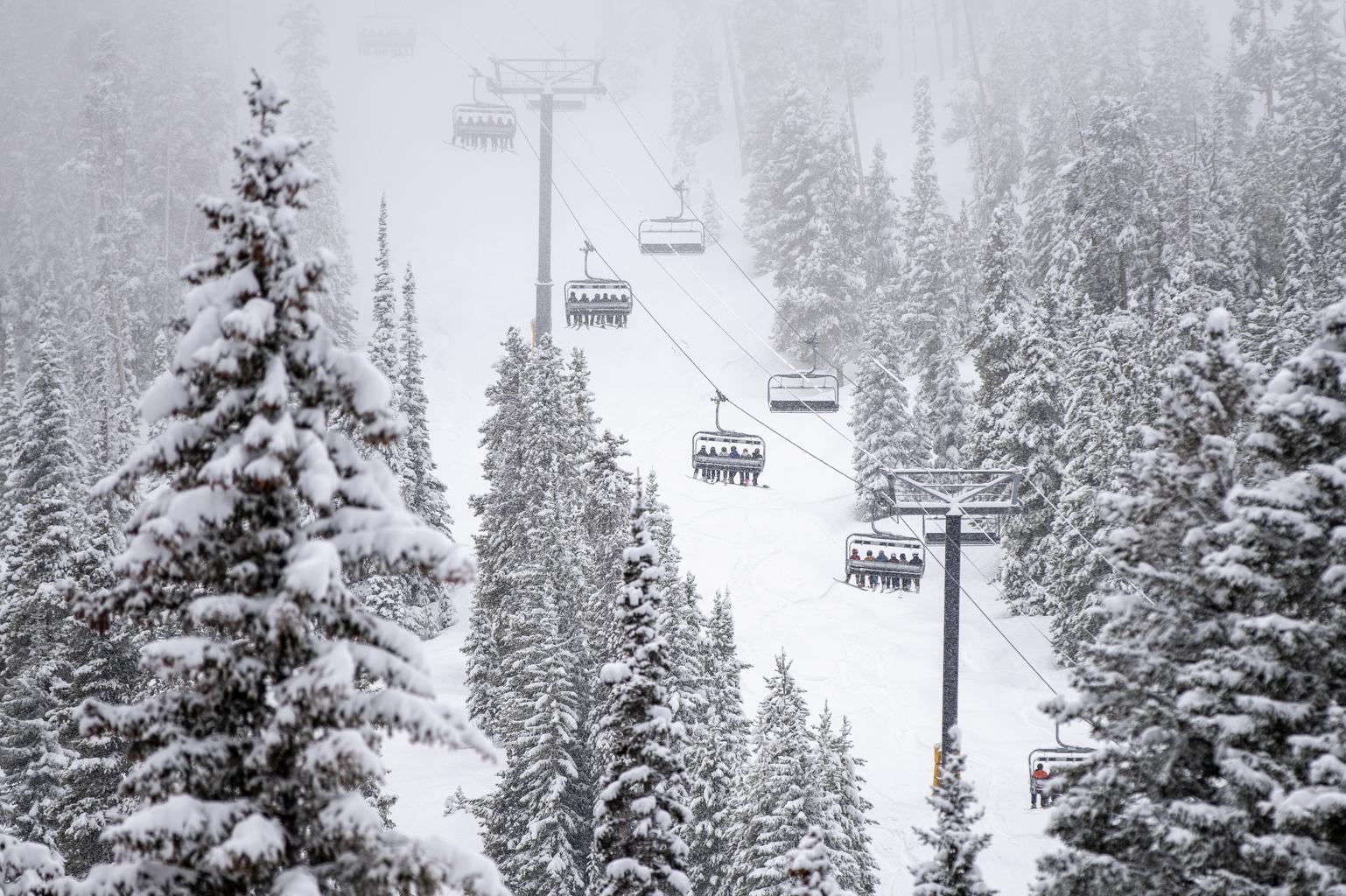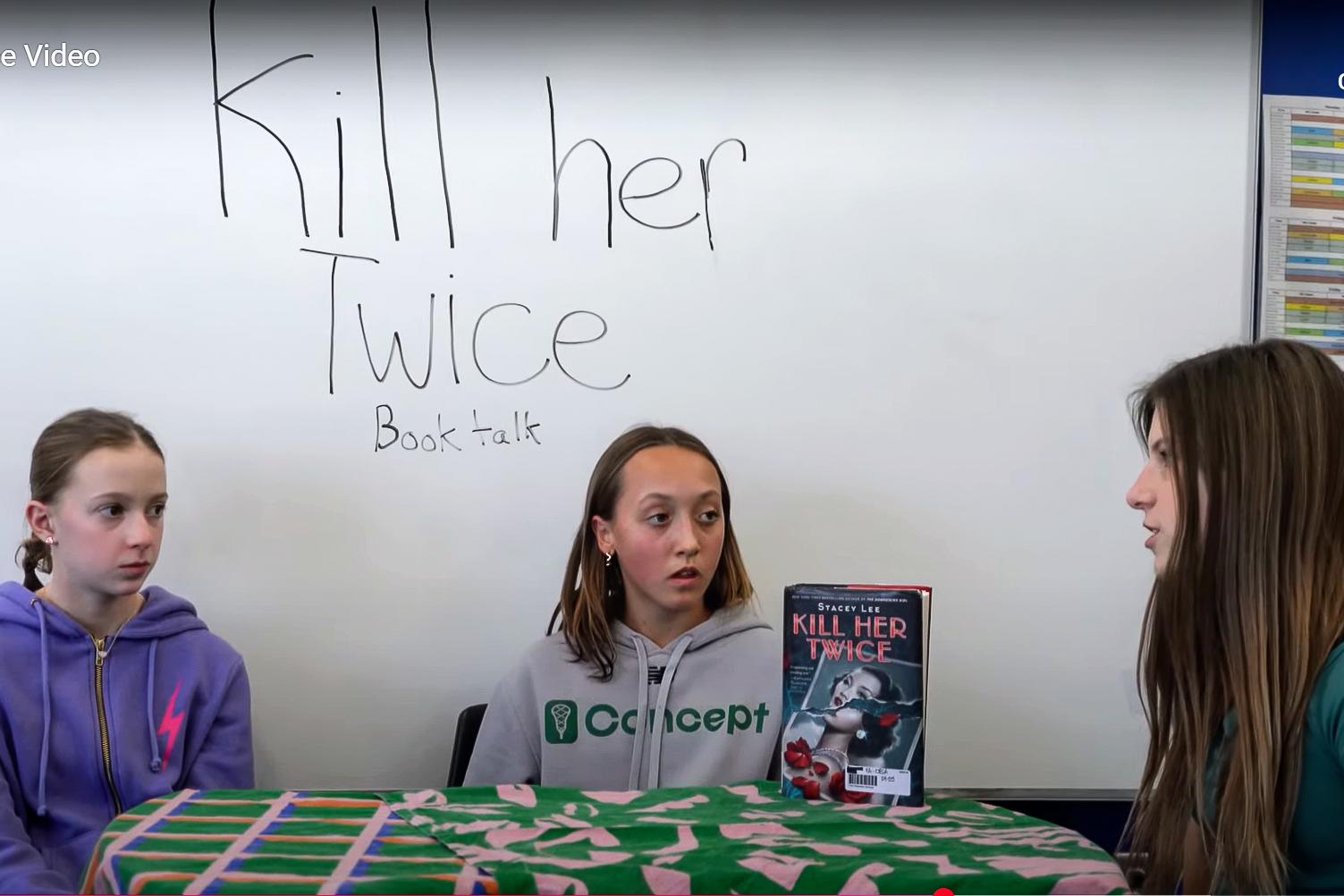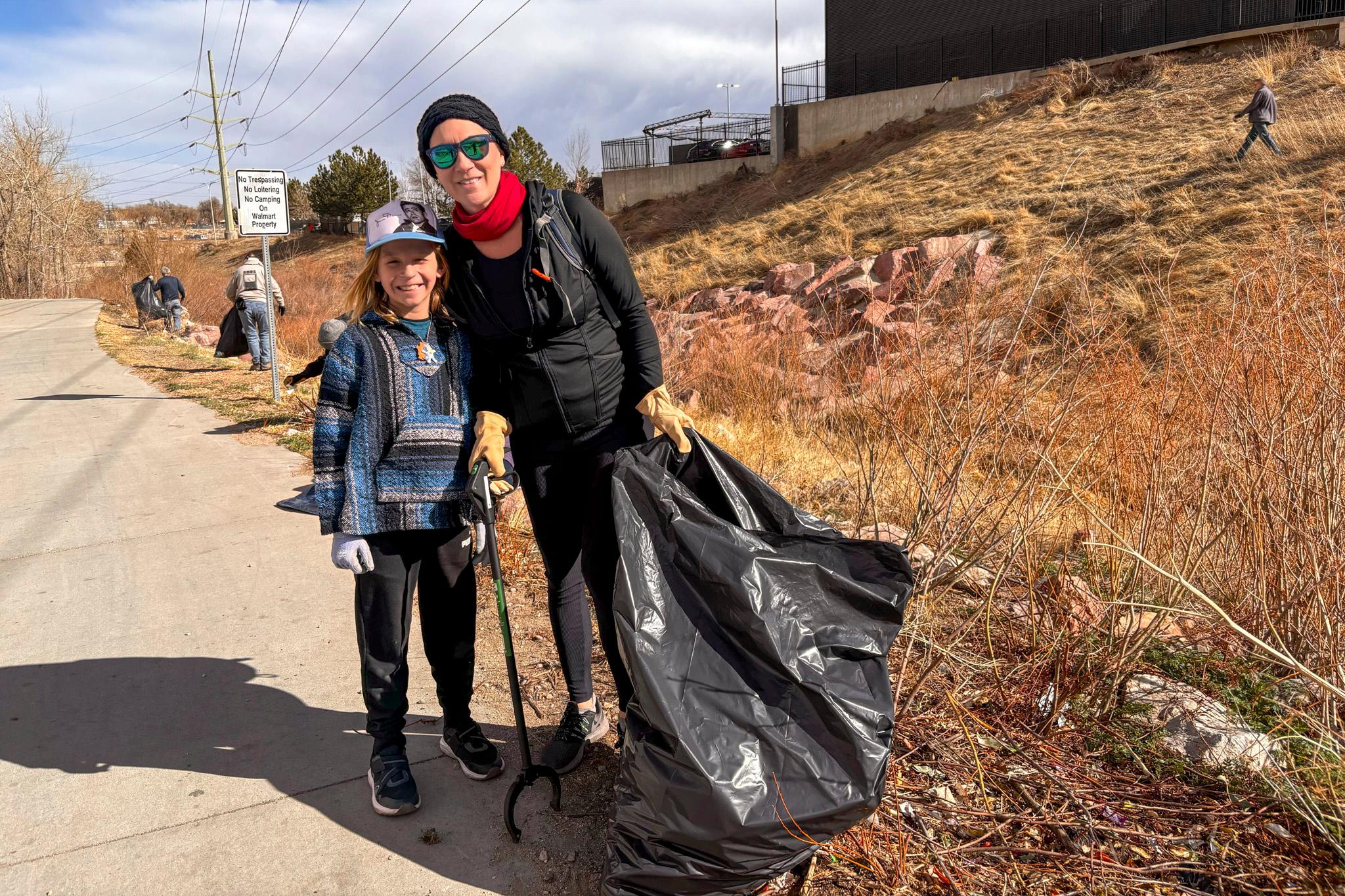
Dick Ray has traveled many roads and countless miles over his several decades living in Colorado.
“I’m old enough to remember when most of this pavement was new, back in the ‘50s and ‘60s when the interstates were built,” he said during a recent stop at a central Denver Conoco station. Ray lives in Pagosa Springs and often makes the drive into the metro.
“It was a wonderful world; so little maintenance,” he said.
But those days are long gone. Millions more people live in Colorado than were around in the 1950s – and there’s millions more to come.
As the population booms, roads deteriorate and traffic congestion worsens. Interstate 25 in the Denver metro area can easily be confused with a parking lot during peak rush hour periods. And those bumper-to-bumper rides down the mountain on Interstate 70 have become big buzz-kills for ski bums.
Vehicles in Colorado traveled 49 billion miles on state highways and roads in 2012. That number is expected to jump to nearly 70 billion by 2040, according to the Colorado Department of Transportation.
“How much more can we stand?” Ray laments. “We need to seriously, really evaluate everything we’re doing and how we’re doing it.”
Roads need upkeep. It often feels as though interstates need more lanes. And there’s constant pressure for more mass transit options, both to help folks get around – and to keep them from contributing to congestion.
The problem is, there’s no money to do any of it.
“Almost all of our budget right now is going to maintaining our system,” said Colorado Department of Transportation Executive Director Shailen Bhatt. “We are not adding capacity in the state.”
Right now, CDOT only has enough money to maintain the state’s highway system in its current condition for the next 10 years.
After that? Current projected state revenues will cover just 46 percent of Colorado’s transportation needs over the next 25 years.
The department faces a $25 billion revenue shortfall over that period, including a nearly $9 billion shortage over the next 10 years.

Meanwhile, the state’s population is expected to climb from its current 5.4 million to an estimated 8 million by 2040. More than 100,000 people moved to Colorado last year alone, as the state posted the second-highest growth rate in the nation, according to the State Demography Office.
“And I think those 100,000 new people who moved here, I think every single one of them brought a car with them,” said state Sen. Pat Steadman, D-Denver. He and his fellow lawmakers of both parties agree that roads need more funding to keep up with population realities. But there is no consensus inside the Capitol as to how to fix those problems.
“I would say that we’re in for some significant challenges and we’re experiencing them – and we’re experiencing them now,” Bhatt said.
Complicated Funding Process For Roads
Colorado is an attractive destination these days, given the state’s diverse economy, low unemployment rate and aesthetic qualities. But Gov. John Hickenlooper acknowledges how the state’s growing pains manifest on our highways.
“We are strangling in our success,” Hickenlooper said. “We have become this destination for millennials; entrepreneurs are flocking here starting businesses, and yet we are not investing into our transportation infrastructure the way we should be.”
The state’s role in providing transportation funding is complicated. Its current transportation funding mechanism – created by 2009’s Senate Bill 228 triggers a five-year block of money transfers to roads and transit projects when the state’s personal income growth reaches 5 percent. Current revenue forecasts project CDOT will receive $200 million for the 2016-2017 budget year.
But future budget year forecasts indicate those transfers will be significantly reduced or even wiped out entirely. That’s because the transfers are, by law, impacted when Colorado taxpayers are due refunds, which is soon to be the case. The Taxpayer Bill of Rights requires tax refunds when state revenue exceeds the rate of inflation and population growth.
The bigger the refund, the less money goes to roads. Right now, refunds on 2015 tax returns are estimated at $157 million, which breaks down to $13-$41 for a single filer. And the slightest adjustment in revenues in either direction can throw a monkey wrench into budget planning due to uncontrollable contingencies.
“It creates these hairpin triggers,” said Tim Hoover, a spokesman for the Colorado Fiscal Institute, a left-leaning think tank. “If you’re up $50 million or down $50 million, you’re either giving huge refunds or making huge cuts and you can’t always tell a few months earlier what the situation is going to be.”
Steadman, who sits on the legislature’s Joint Budget Committee, a group that’s tasked with writing the annual budget, says lawmakers would like to change the current highway funding mechanism into something more reliable, but that won’t be easy.
“That’s going to be a pretty difficult conversation and it’s not clear that if we were to reopen that law, that we could find consensus on a different way to do it,” Steadman said. “So, we may just have to get used to the uncertainty and the unpleasant surprises that a forecast and a change in an estimate bring about.”
Stagnant Gas Tax Hampers CDOT's Biggest Revenue Source
Hoover describes any amount of funding CDOT receives from the state as “found money.” That’s because the vast majority – 61 percent – of CDOT revenues comes from state and federal gas taxes.
The state’s gas tax, which is currently 22 cents per gallon, has not changed since 1992. And the gas tax does not rise when gas prices go up. Colorado’s gas tax falls below 34 other states –including neighboring states of Nebraska, Utah and Wyoming, which have raised their gas taxes over the last few years.
On top of that, a dollar from 1992 is worth about 40 cents today.
“You can’t buy a car today for what you paid in 1992,” Bhatt said. “You can’t buy a house today for what you paid in 1992. But we are investing in our transportation system like it’s 1992.”
And, with more fuel-efficient vehicles on the roads that require fewer stops at the pump, revenues collected from the gas tax continue to dwindle.
The gas tax may not increase any time soon. But a proposal to increase the state’s sales is currently in the works.
Disagreement Over Alternate Funding Sources
Bill Ray (no relation to Dick), a consultant for the Colorado Contractors Association, said polling shows that Coloradans are open to a sales tax increase for transportation funding. He said it is “likely” that a measure could end up on the November ballot.
However, Minority Leader Brian DelGrosso, R-Loveland, believes there are solutions to the transportation funding shortfall, but he doesn’t think Colorado voters have an appetite for increased taxes -- something even Democrats acknowledge.
“Quite frankly, the voters of Colorado are still not very excited about digging deeper into their wallets to do that,” DelGrosso said. “(Voters say) ‘Look, we’re sending you a bunch of money as it is; maybe we don’t like where you’re spending money now.’”
Instead, DelGrosso and other Republicans favor a proposal to seek voter approval for $3.5 billion in bonds for highway project funding.
But that has been a non-starter for Democrats who say the state can’t repay the bonds.
“If you don’t have a way to pay for it, you shouldn’t be going out there and trying to bond against money you don’t have,” said Rep. Max Tyler, D-Lakewood, who chairs the House Transportation and Energy Committee. “That’s just plain foolish.”
Democrats prefer a Hickenlooper-backed proposal that would reclassify the Hospital Provider Fee program. These are fees hospitals collect as state revenue to obtain federal funds that have helped expand Medicaid and other health services for low-income residents.
Democrats want to reclassify these fees as TABOR-exempt revenue. This could free up hundreds of millions of dollars in revenue for education and transportation -- as much as $756 million for the next fiscal year.
But Republicans have balked at the proposal. And even Hickenlooper acknowledges the freed-up revenues would only provide a short-term funding solution for roads.
“I don’t think the Hospital Provider Fee solves all the problems of the state, but it does allow us to provide some big improvements,” he said.
The governor said he would be open to a bonding measure if an agreement can be reached on the hospital provider fee. The governor said the state would then have more money available to pay the bonds. Republican leadership has yet to talk publicly about whether a potential compromise is on the table.
In the meantime, Bhatt said his department is trying to make do with existing resources, as well as to seek innovative solutions. On major road expansion projects, CDOT has turned to public-private funding partnerships, such as the one that resulted in recent improvements to US 36 between Denver and Boulder. Private money helps fill the gaps in projects that the state can not fully fund on its own.
But Bhatt says those partnerships can only go so far if the state doesn’t have the resources to woo contractors -- and the ability to pay them back. As far as toll lanes go, Bhatt said they provide very little revenue and are used primarily to mitigate congestion.
The bottom line, Bhatt said -- Colorado roads need more money.
“People are already paying more for transportation in Colorado. They’re paying more in terms of the frustration. They’re paying more in terms of congestion. They’re paying more when they could be at home with their family [instead of being stuck in traffic].”
Steadman says taxpayers need to start understanding the sense of urgency.
“We’re going to have to break out of the mindset of ‘We want government services. We want government to provide infrastructure, but we don’t want to pay for it. We just want a tax refund,’” Steadman said. “Folks, that doesn’t work. It’s not logical. And it’s not how you fund important infrastructure that our economy depends on.”
As lawmakers try to figure things out, Reggie McGee of Denver tries to be patient. He had just pulled into a gas station after getting off of the Colorado Boulevard exit at I-25.
“They need to come up with some kind of alternative because traffic is just too backed up,” McGee said, who has lived in Colorado all of his life.
McGee was then asked how he manages to get through all of this traffic.
“Slow. Take your time.”








